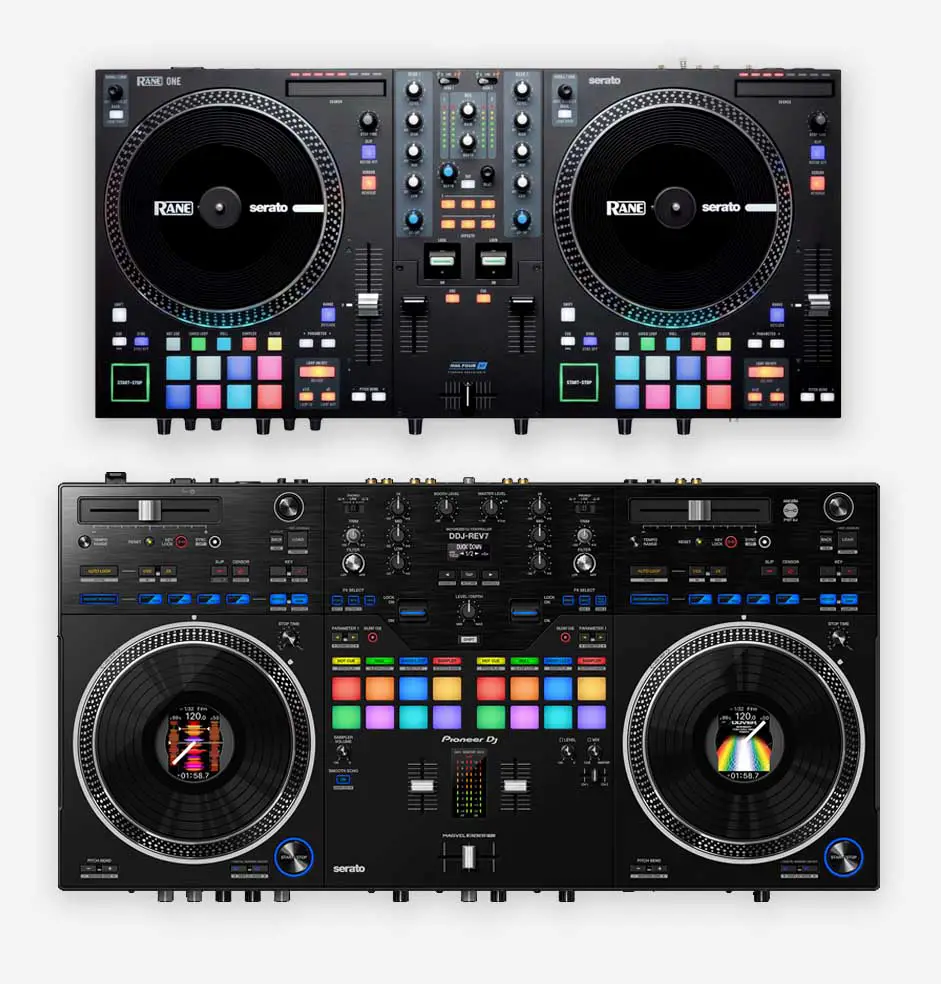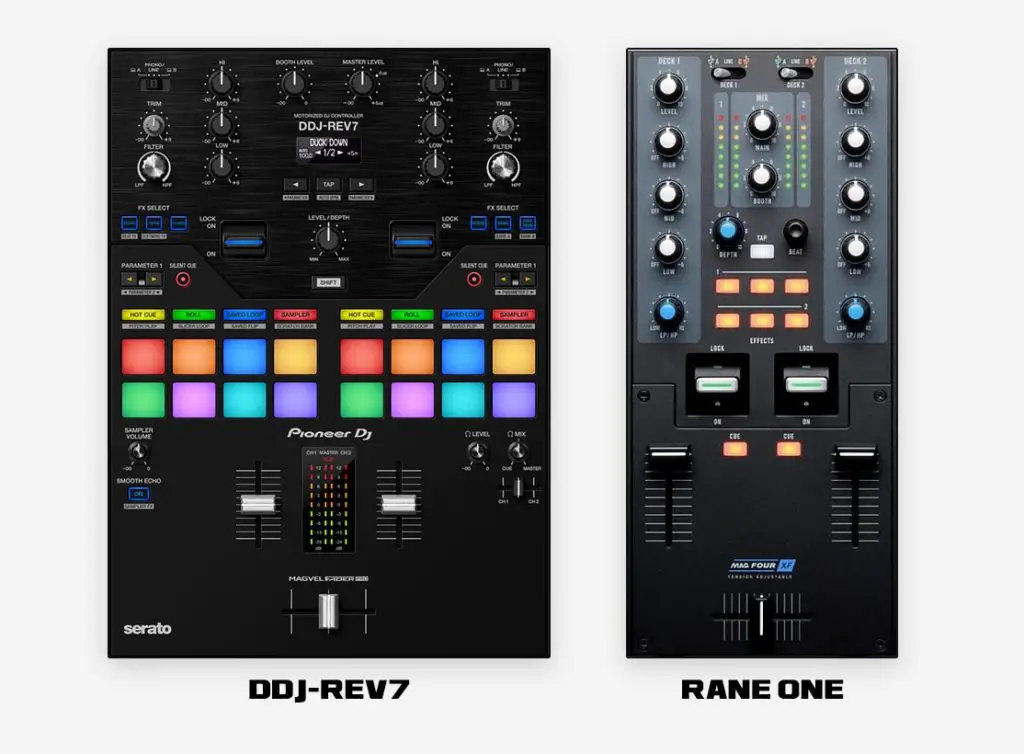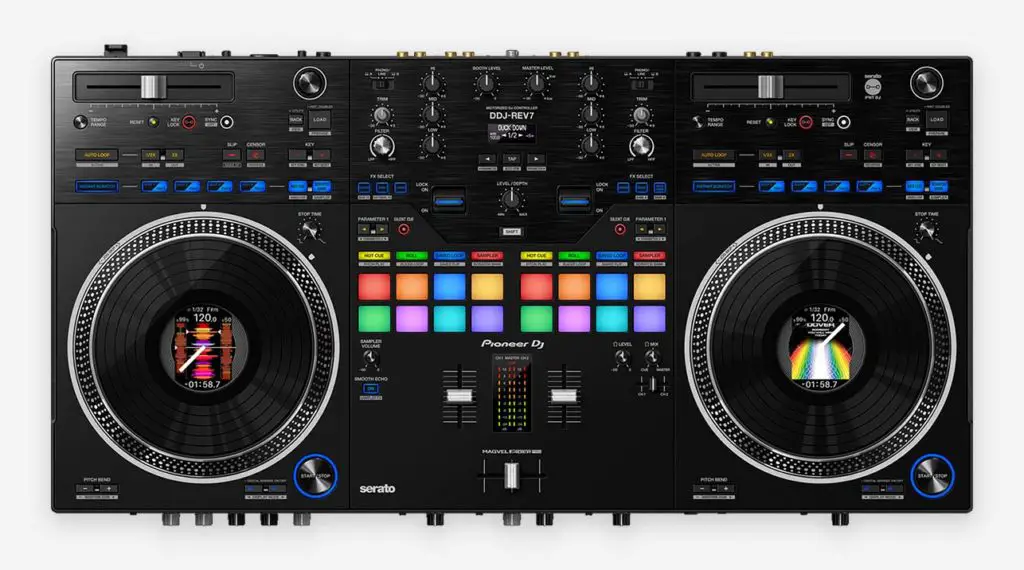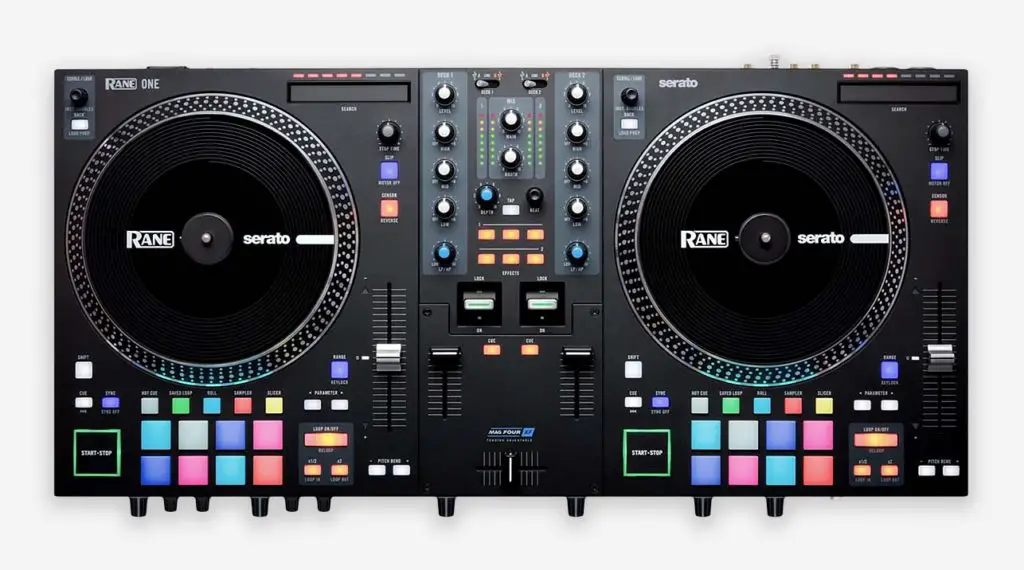Rane ONE vs. Pioneer DDJ-Rev7 ultimate DJ controller comparison. Which DJ controller with motorized platters is better? Which one should you choose this year? There are some substantial differences that make these two controllers unique. We will now dive into all the details and compare all the main features of these top quality devices. Let’s jump straight into the hardware comparison.
- Main differences + the control layout
- The crossfader
- Mixer sections
- Audio FX sections
- Performance pads
- Jog wheels
- Inputs and outputs
- Software compatibility
- Pros and cons
- The price
- The conclusion – which one should you get?
This web portal is reader-supported, and is a part of the Amazon Services LLC Associates Program and the eBay Partner Network. When you buy using links on our site, we may earn an affiliate commission!
Check out also: Rane FOUR vs. Rane ONE (Our Comparison!)
Main differences + the control layout

The Pioneer DDJ-Rev7 is slightly bigger than the Rane One, however both devices weigh around (23 lb / 10 kg) placing them on the heavier side of the DJ hardware spectrum near the Denon DJ Prime 4 (21 lb) and the Pioneer XDJ-XZ (29 lb).
The similar weight of these units is interesting, as the Rane One features an in-built power supply while the Pioneer DDJ-Rev7 utilizes an external power brick. Thus we would expect the Rane One to be much heavier than the Rev7 because of the built-in transformer, and that isn’t the case.
Pioneer DDJ-Rev7 features a typical battle style controller layout which resembles two turntables turned counterclockwise and an audio mixer in the middle (that’s why the pitch faders are located on top of each deck).
What Is A Battle Style DJ Controller Layout? – Quickly Explained
Rane One on the other hand, features a classic asymmetrical club layout with pitch faders placed on the right side of each deck and performance pads located under each jog wheel.
DDJ-Rev7 lacks a search strip feature
A major difference that may be important for many of you, is that the DDJ-Rev7 doesn’t feature a search strip which allows you to quickly move and search through a track. Instead, on the Rev7 you are supposed to hold the shift button and move the jog wheel to navigate through your tracks quicker.
The Rane One features a separate search strip for each deck.
Other important differences
Another small yet important detail is that the Rane One has 4 large rubber finished feet that allow you to place you cables or your laptop stand parts underneath it, whereas the DDJ-Rev7 has a flat bottom which doesn’t leave you any space beneath.
DDJ-Rev7 also has 3 additional utility features – Smooth Echo, Instant Scratch & Silent Cue functionalities that are described in our review here.
It is also important to note that the DDJ-Rev7 doesn’t have temporary cue buttons on the decks – it features just a single start/stop button resembling a real turntable. Rane One has a small temporary cue button on each deck.
The last general difference between the two would be the power supply. The Pioneer DDJ-Rev7 utilizes a classic external power brick that comes with the device, while the Rane One has an in-built power supply and requires just a simple standard power cable to work (also included).
The crossfader
DDJ-Rev7 features a Magvel crossfader, while the Rane One features a Mag Four crossfader.
Crossfaders on both the DDJ-Rev7 and the Rane One are fully adjustable, but while the DDJ-Rev7 has a dedicated crossfader tension control knob, the Rane One requires removal of the front mixer plate to access the crossfader tension regulation mechanism.
The crossfader curve can be customized by using a dedicated knob on both of these devices.
Mixer sections

With the difference in size and layout type, comes the difference in mixer section control scheme. The mixer section on the Rane One is much narrower than the one on the DDJ-Rev7, and it doesn’t feature performance pads, as on the Rane One these are present on individual decks.
New Pioneer DDJ-Rev7 – DJ Controller Detailed Review
Mixer on the Pioneer DDJ-Rev7 is modeled after the Pioneer DJM-S11 standalone DJ mixer, while the Rane One mixer layout follows a standard classic DJ mixer control scheme. Choosing one layout over the other is purely a matter of user preference.
The audio FX controls ale placed in the middle of the mixer sections on both these devices. Let’s compare both the FX sections now.
Audio FX sections

While the Rane One can only make use of the Serato DJ software FX (it simply lets you control the software effector using the hardware buttons), the Pioneer DDJ-Rev7 lets you use Serato DJ software FX plus a set of 22 hardware FX (Pioneer Beat FX built into the hardware).
In terms of a large variety of Audio FX made available for you, and also the presence of actual in-built hardware FX, the Pioneer DDJ-Rev7 is a winner.
When it comes to general quality of FX controls, both devices are pretty much the same, however its important to note that the Pioneer DDJ-Rev7 features an additional LCD screen in the middle of the FX section that can display various FX parameters and see which FX are active at a time.
More on the Pioneer DDJ-Rev7 FX section in our detailed review of this controller here.
Performance pads

One substantial difference between the Pioneer DDJ-Rev7 and the Rane One is the placement of the performance pads. On the Rev7, they are located in the middle of the mixer section resembling the Pioneer DJM-S11 standalone DJ mixer layout.
On the Rane ONE, the performance pads are placed under each platter which is a common pad placement in DJ controllers with club control layouts.
In terms of performance pad quality both devices are comparable, however the DDJ-Rev7 also features a bonus set of 4 buttons on each deck that can be used as additional performance pads. The ability to have more performance pad like controls is a really nifty feature! More on that here.
Both DDJ-Rev7 and the Rane One feature exactly the same pad modes, as they are both dedicated Serato DJ software controllers. On the Rane One however, the secondary pad modes don’t have text descriptions under the pad mode buttons like on the Rev7.
Jog wheels

New Pioneer DDJ-Rev7 – DJ Controller Detailed Review
When it comes to the excellent motorized platters these devices feature, there are a few key differences here:
- DDJ-Rev7 features a LCD screen on each jog wheel that can display track details, waveforms or your custom imported images.
- Minor pitch corrections on the Rane One are done in the traditional way – using the spindle in the middle of the platter, and as the DDJ-Rev7 has its jog wheel displays, it doesn’t feature spindles so the small pitch corrections can be done by pressing the pitch bend buttons located at the bottom of each deck or using the edge of the platter.
- On the Rane One you can disable the platter movement completely, on the DDJ-Rev7 you don’t have that ability.
- Pioneer DDJ-Rev7 utilizes slip rings, while the Rane One features a more traditional shrunken slip mats underneath the vinyl-like acrylic platter surfaces. This doesn’t really affect the feel of the respective device’s platters much.
- The jog wheels of both devices are very similar in size (~7″).
Inputs and outputs
DDJ-Rev7:
| Inputs: | – 2x Phono/Line (RCA) – 2x Mic (XLR & 1/4 inch TRS jack, 1/4 inch TRS jack) – 1x Aux (RCA) |
|---|---|
| USB: | – 2x USB B ports |
| Outputs: | – 2x Master (XLR, RCA) – 2x Booth (1/4 inch TRS jack) – 2x Headphones (1/4 inch stereo jack, 1/8 inch stereo jack) |
Rane One:
| Inputs: | – 2x RCA stereo input (Deck 1–2) – 2x XLR / 1/4 inch (6.35 mm) TRS inputs (Mic 1–2) – 1x Aux (RCA) |
|---|---|
| USB: | – 2x USB B ports |
| Outputs: | – 2x Master (XLR, RCA) – 2x XLR (Booth) – 2x Headphones (1/4 inch stereo jack, 1/8 inch stereo jack) |
Whats important to note is that while the Pioneer DDJ-Rev7 has a 2x TRS 1/4 inch jack booth output, the Rane One uses a XLR output for the DJ booth speakers out.
Both devices have dual USB i/o support for easy back-to-back mixes.
Other than that, the Rane One features a separate EQ for each microphone input, when on the DDJ-Rev7 one EQ controls both the microphones, DDJ-Rev7 has a mic talkover mode and a mic echo effect that the Rane One lacks.
Software compatibility

Both of these devices are dedicated Serato DJ Pro controllers and will work flawlessly with Serato software. They also both come with the full version of Serato DJ Pro, however the Pioneer DDJ-Rev7 also features a Serato Pitch ‘n Time expansion pack which is normally sold as a paid addon.
Pioneer DDJ-Rev7 and Rane One work with Virtual DJ software, albeit both these controllers require a Pro Infinity or a Pro Subscription license to use them.
Sadly neither DDJ-Rev7 nor the Rane One are compatible with Rekordbox software.
Pros and cons

Pros:
- Battle style control layout perfect for scratch DJs
- Jog wheel displays
- Additional buttons on each deck doubling as performance pads
- 22 high quality hardware FX
- Mixer layout modeled after famous Pioneer DJM-S series
- Originally comes with Serato Pitch ‘n Time DJ expansion pack
- Additional Smooth Echo & Silent Cue functions
- Crossfader tension customized using a simple knob
Cons:
- No temporary cue button
- No possibility to turn off the platter motors
- A lot pricier than the Rane One
- Doesn’t feature an in-built power supply – the Rane ONE does
- No search strip functionality

Pros:
- Smaller than DDJ-Rev7 and has space underneath because of the rubber feet
- A classic spindle in the middle of each jog wheel
- Track search strip on each deck
- Temporary cue button is present on the device
- Less expensive than the DDJ-Rev7
- In-built power supply
Cons:
- Customizing the crossfader tension is possible only after removing the mixer cover
- No hardware FX – you are limited to the Serato DJ software effects
- No jog wheel displays
The price
Pioneer DDJ-Rev7 while definitely being richer in features, is also much more expensive than the Rane One. You can check the current prices of both devices on the official brand stores on Amazon here: Pioneer DDJ-Rev7, Rane One.
| Controller | Features | Price |
|---|---|---|
| Pioneer DDJ-Rev7: – Battle style layout. – Motorized platters. – Best you can get for the price. | Check price on Amazon Check price on Ebay | |
 | Rane ONE: – Standard club layout. – Motorized platters. – More compact and cheaper. | Check price on Amazon Check price on Ebay |
The conclusion – which one should you get?
When it comes to DJ controllers with motorized platters, the Pioneer DDJ-Rev7 and the Rane One are among the best choices in current year. If you’re looking for alternatives, then there is also the Numark NS7 III. Whichever of these you’ll choose you can be assured that you’re getting premium level advanced DJ equipment that will last you a long time. It would be however dishonest to omit the fact that the Pioneer DDJ-Rev7 is currently the most advanced device from the mentioned hardware. Pick one up and enjoy the vinyl emulation experience! Rock on!
| Pioneer DDJ-Rev7 on Ebay: |
| Rane One on Ebay: |
You might also like: Rane ONE – Is It Still Worth It In The Current Year? (Should you get it?)

